Our Origin 600 Acoustic Doppler Current Profiler (ADCP), already established for its advanced data collection capabilities, takes underwater observations to a new level thanks to its recently introduced echosounder mode. From monitoring fish behaviour to examining seaweed growth, its innovative design offers unique insights that can revolutionise aquaculture and marine research.
This trial report outlines the benefits of echosounder mode and highlights findings from two trials. Whether you’re in aquaculture, marine research or any field demanding accurate underwater data, read on to discover how this technology transforms underwater monitoring.
Trial highlights
Working with SINTEF Ocean on a project called BEDLAM (Biomass using Echosounding and Doppler for Live Aquaculture Monitoring), which was funded by the AQUAEXCEL 3.0 Transnational Access Program. Two, month-long, trials were conducted in Norway with Origin 600 ADCP to evaluate its functionality in real-world environments. The trial’s aim was to measure fish growth and behaviour, as well as seaweed growth to gain an insight into how their environments are impacting their production and how to make production more efficient.
The role of a lander in deployment
Central to the successful functioning of both of the trials was the use of the Origin Seabed Lander. The lander kept the ADCP firmly in position and ensured data consistency despite external variables such as currents or waves. Its implementation provided several practical benefits:
- Stability: The ADCP maintained a fixed viewing angle, resulting in reliable observations throughout the trials.
- Targeted monitoring: The lander enabled precise deployment angles to intersect specific targets, such as fish pens or seaweed ropes.
- Ease of maintenance: It facilitated straightforward ADCP retrieval for analysis and calibration without disrupting the environment.
- Integrated release mechanism: No need to source equipment from multiple vendors and integrate it yourself.
- Extra power: The lander can hold extra external batteries to extend deployment duration and support faster ping rates.
The lander’s role ultimately pushed Origin 600’s capabilities even further, ensuring meticulous and reproducible data collection.
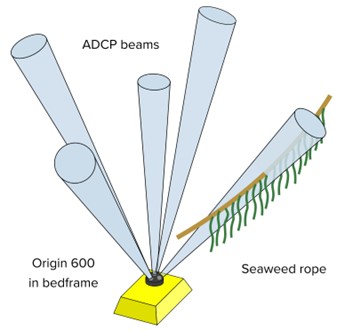
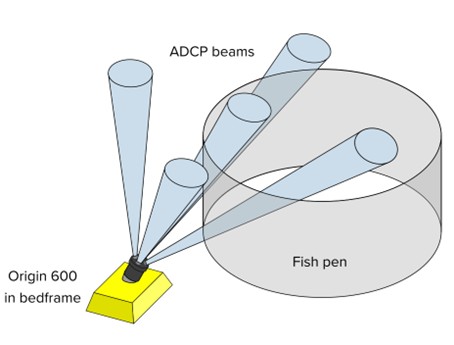
A common problem in aquaculture is interpretation of the intricate data, which requires expert (and therefore costly) knowledge. Origin 600 ADCP has built-in Edge processing which simplifies the complex data captured.
With Edge, complex data is distilled into simple metrics that are practical for site operators to use and easier to interpret. Because the data packets are reduced in size by processing out any superfluous information, the data can be transmitted to the surface via the on-board modem. Using external batteries in the lander allows for longer periods of refined data collection.
Trial 1: Seaweed growth observation
The first trial was a month long and explored seaweed growth at a seaweed farm near Frøya. Beam four of the ADCP intersected a rope hosting seaweed. Findings included:
- Seaweed position tracking: The echosounder mode effectively recorded the seaweed’s position relative to tidal phase and currents.
- Wave influence: Observations revealed that the effects of surface waves propagated down to the seaweed, which then interacted with the waves.
- Growth trends: Although this trial detected minimal growth during its short duration, longer deployments could uncover actionable insights into seaweed growth patterns.
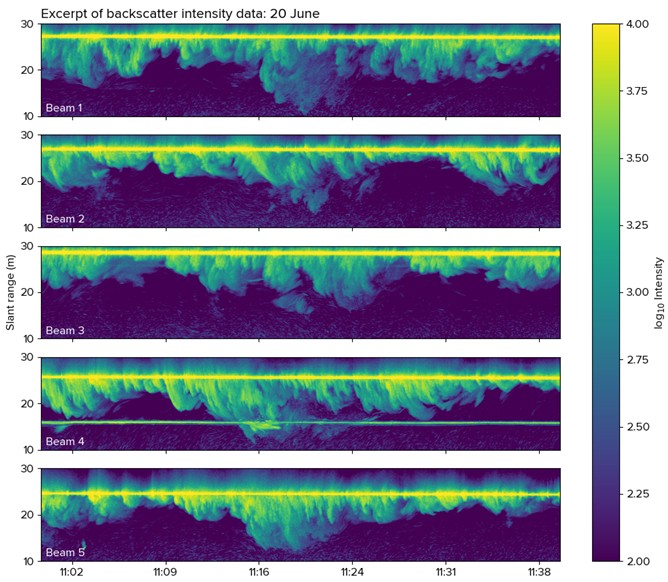
Excerpt of backscatter intensity for all ADCP beams monitoring the seaweed, showing the influence of waves well below the surface. Beam four shows the seaweed rope as the lower horizontal line.
Trial 2: Monitoring fish in a salmon farm
The second trial positioned Origin 600 ADCP at a salmon farm near Hitra, for a month-long (4th – 31st July 2024) deployment. By aligning one beam directly through a fish pen, the ADCP’s echosounder mode enabled continuous monitoring of the fish. Observations from this trial included:
- Fish movement insights: The fish exhibited vertical movement patterns connected to tidal cycles, rising toward the surface during high tide and descending at low tide.
- Clustering and bulk motion: The system successfully tracked the clustering and bulk motion of fish over time.
- Biomass monitoring: Acoustic attenuation assessments hinted at the potential to use this data as a proxy for biomass density. This could prove invaluable for monitoring fish health and pen management.
- Real-time data: The ADCP’s built in acoustic modem gave acoustic connectivity to the surface and delivered real-time data to a Cloud portal for SINTEF scientists.
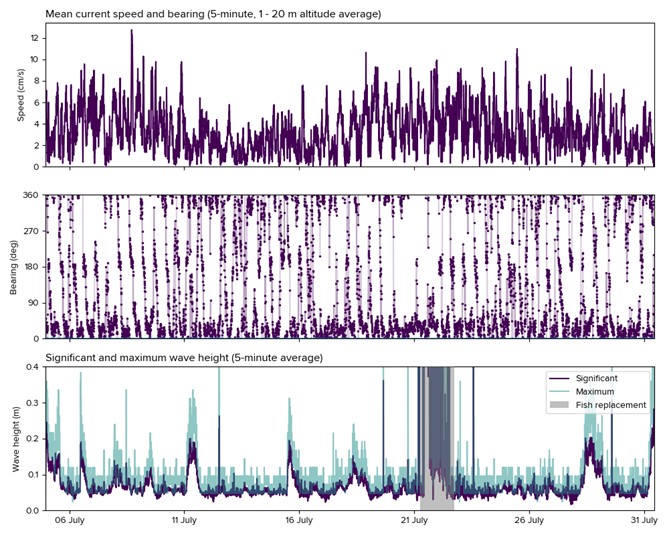
Currents and wave results for the whole fish farm deployment using modified Waves app algorithm with five minute averaging.
These trials underscore the versatility and precision of echosounder mode for marine monitoring applications.
Why echosounder mode stands out
Echosounder mode on Origin 600 isn’t just a functionality upgrade; it’s a game-changer. Here are the top reasons why this mode outshines conventional monitoring methods:
Real-time fish behaviour analysis
The ability to observe and quantify fish movements dynamically provides unmatched aquaculture insights. With minute-level detail, behavioural patterns—including feeding habits and stress levels—become apparent. For instance:
- Oscillations in fish movement during tidal cycles were clearly documented.
- Surface tracking algorithms enabled high-accuracy motion analysis, even when the fish pen was refilled mid-trial.
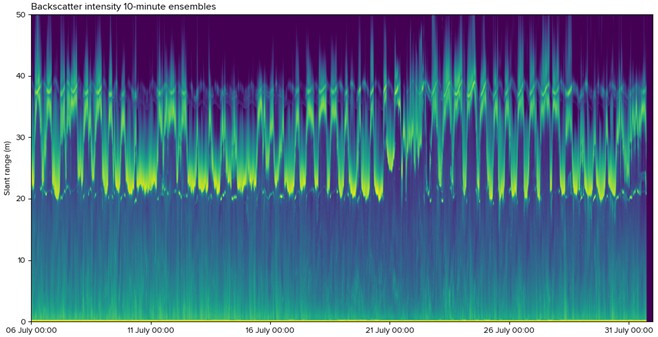
Fish farm ADCP beam five backscatter intensity data for the whole deployment
Biomass density estimation
Echosounder mode data can be used to measure backscatter intensity from both fish and seaweed. When calibrated and tracked over time, this allows estimation of biomass growth rates, indicating species health and helping establish optimal harvest times.
Seaweed monitoring
Seaweed farms benefit significantly from echosounder mode. Its high spatial resolution allows operators to:
- Quantify seaweed layer thickness and position over time.
- Evaluate tidal and wave influences on the structure and health of the crop.
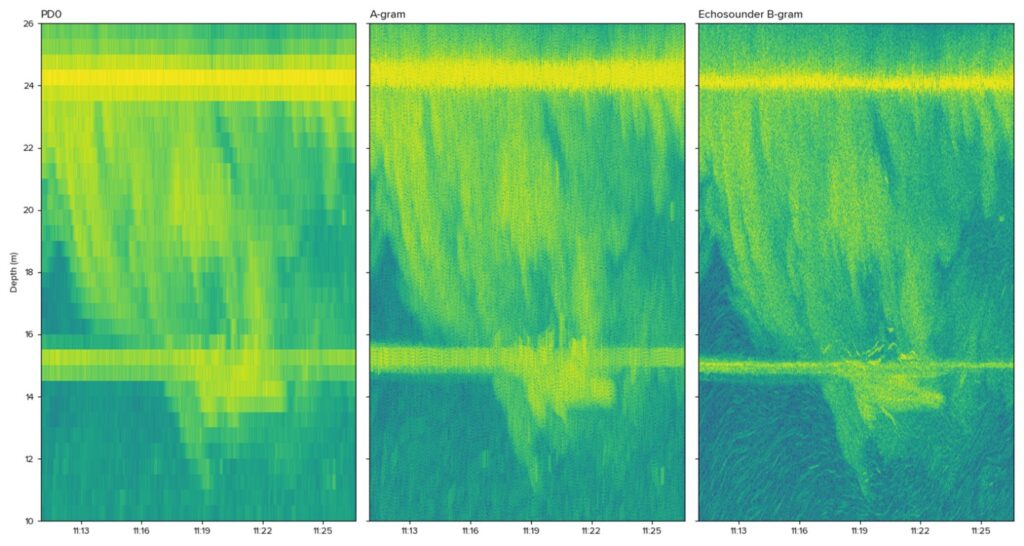
Comparison between data in standard ADCP PD0, Origin ADCP A-gram and echosounder B-gram format showing interaction between waves and the seaweed rope.
Finer detail in the data
Compared to traditional ADCP measurements, echosounder mode delivers data with higher spatial resolution. This increased granularity is critical in:
- Identifying subtle oscillations in aquatic environments.
- Differentiating between scatterers like fish, seaweed and debris.
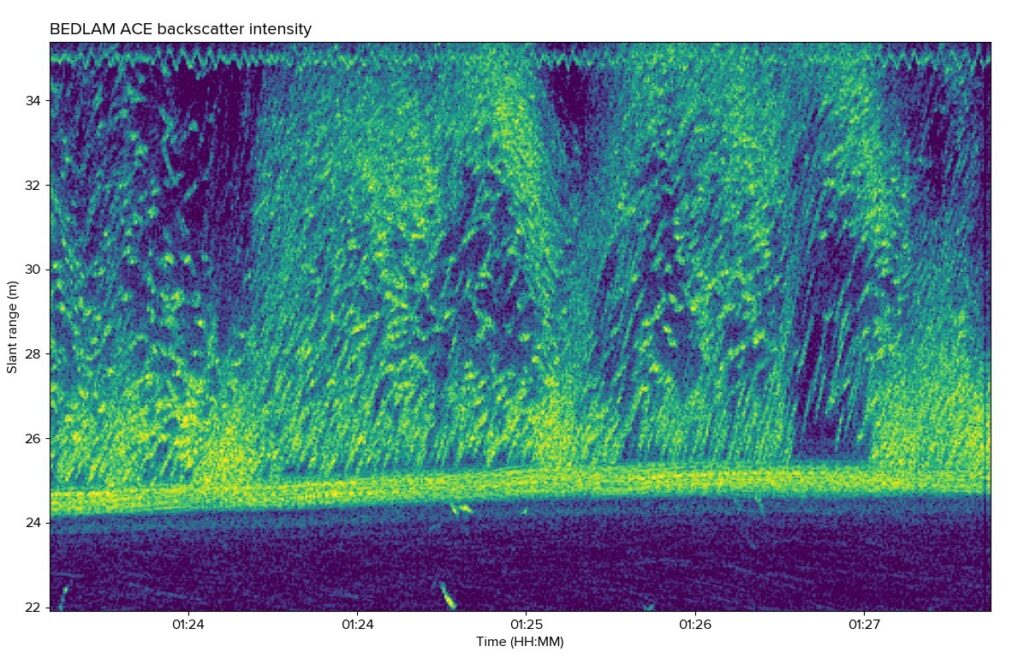
Echogram showing backscatter intensity in finer detail at the Hitra salmon farm. The sea surface can be seen at an altitude of around 35m; small waves can be clearly seen. The solid line at an altitude of 25m corresponds to the fish pen net. Backscatter from fish inside the pen can be seen between these two limits; this data shows a variety of phenomena related to both bulk biomass and individual salmon. A small number of wild fish outside the pen can be seen beneath the pen net; these fish are likely scavenging uneaten feed as it falls out of the pen.
Multi-application versatility
From aquaculture to scientific research, echosounder mode adapts seamlessly to diverse scenarios. Monitoring fish, analysing seaweed growth or tracking marine scatterers are only the tip of the iceberg in terms of potential applications.
Insights into fish observation capabilities
The ability to visually interpret fish behaviour in real-time offers aquaculture businesses groundbreaking insights. These include:
- Feeding patterns: Sudden clustering at specific times could point to feeding or stress-related behaviour.
- Stress indicators: Vertical movement oscillations on shorter timescales may indicate unusual activity, potentially signalling environmental stressors within the fish pen.
Origin 600 contains an in-built acoustic modem allowing data collected and processed by the unit to be communicated wirelessly through the water to a surface transceiver. This real-time observability allows operators to ensure optimum fish welfare and adjust management practices rapidly. See below for more about the onboard processing.
Monitoring seaweed growth and ecosystem dynamics
Seaweed farming, an increasingly vital component of sustainable aquaculture, benefits from the precision and innovation of Origin 600. With its echosounder mode, users can:
- Observe seaweed growth layer dynamics over time against tidal phases.
- Gauge the influence of external factors, such as waves and currents, on seaweed ecosystems.
- Detect anomalies in the water column, such as particle densities that could affect farming conditions.
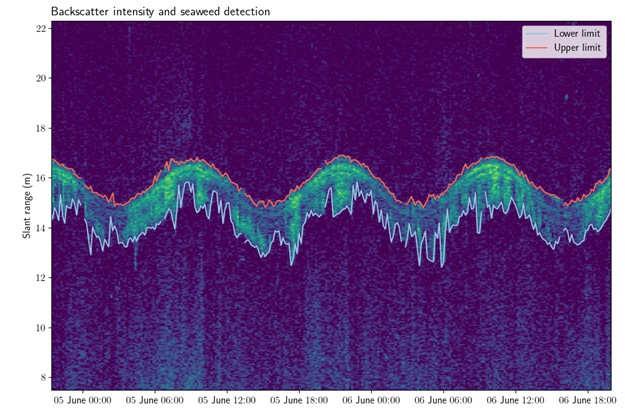
Detected seaweed positions overlaid on backscatter intensity data
While the trials focused on feasibility and initial insights, the potential for seaweed monitoring using echosounder mode is immense. Long-term deployments may reveal essential growth patterns and environmental interactions.
Unveiling the future of echosounder innovation – where precision meets possibility
Origin 600’s echosounder mode unlocks unparalleled opportunities to explore and optimise underwater ecosystems. Whether you’re an aquaculture expert, a marine biologist or a researcher, this technology sets an exceptional standard for real-time monitoring and analysis.
Its echosounder mode heralds an era of exciting possibilities across marine research and aquaculture. Effective fish monitoring, innovative biomass measurement and ecosystem mapping only scratch the surface of what this technology promises.
Moving forward
Future research could expand on:
- Enhancing clustering and tracking algorithms to refine bulk motion data.
- Extended deployment durations to uncover trends in processes such as fish growth or seaweed cultivation.
- Continuing advancements in acoustic backscatter assessments for more precise biomass density metrics.
By fostering improvements in data acquisition and feature recognition, the Origin 600 promises to remain a key tool in understanding and nurturing aquatic environments.
Watch the video below to find out more:
